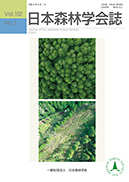Volume 102, Issue 1
Displaying 1-12 of 12 articles from this issue
- |<
- <
- 1
- >
- >|
Articles
-
2020Volume 102Issue 1 Pages 1-6
Published: February 01, 2020
Released on J-STAGE: April 01, 2020
Download PDF (1468K) -
2020Volume 102Issue 1 Pages 7-14
Published: February 01, 2020
Released on J-STAGE: April 01, 2020
Download PDF (49811K) -
2020Volume 102Issue 1 Pages 15-23
Published: February 01, 2020
Released on J-STAGE: April 01, 2020
Download PDF (2595K) -
2020Volume 102Issue 1 Pages 24-30
Published: February 01, 2020
Released on J-STAGE: April 01, 2020
Download PDF (1001K) -
2020Volume 102Issue 1 Pages 31-37
Published: February 01, 2020
Released on J-STAGE: April 01, 2020
Download PDF (1309K)
Short Communications
-
2020Volume 102Issue 1 Pages 38-43
Published: February 01, 2020
Released on J-STAGE: April 01, 2020
Download PDF (5893K)
Review
-
2020Volume 102Issue 1 Pages 44-53
Published: February 01, 2020
Released on J-STAGE: April 01, 2020
Download PDF (7857K)
Special Issue "The Perspectives of Researches in Forest Education"
Preface
-
2020Volume 102Issue 1 Pages 54-57
Published: February 01, 2020
Released on J-STAGE: April 01, 2020
Download PDF (743K)
Articles
-
2020Volume 102Issue 1 Pages 58-68
Published: February 01, 2020
Released on J-STAGE: April 01, 2020
Download PDF (969K) -
2020Volume 102Issue 1 Pages 69-76
Published: February 01, 2020
Released on J-STAGE: April 01, 2020
Download PDF (1319K)
Short Communications
-
2020Volume 102Issue 1 Pages 77-82
Published: February 01, 2020
Released on J-STAGE: April 01, 2020
Download PDF (984K) -
2020Volume 102Issue 1 Pages 83-89
Published: February 01, 2020
Released on J-STAGE: April 01, 2020
Download PDF (1283K)
- |<
- <
- 1
- >
- >|
